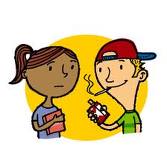Peer Pressure:
= the pressure that you feel to do what others your age (individuals or groups) are doing.
An example of POSITIVE peer pressure:
= role models (e.g. people who get good grades, have good study habits, volunteer in the community)
An example of NEGATIVE peer pressure:
= gangs (e.g. groups that may be involved in bullying, theft, vandalism, etc.)
Three (3) most common methods used to pressure peers are:
- Appeal to your courage
e.g. “What are you chicken?”
- Appeal to your desire to be accepted (or fit “in”)
e.g. “Only the cool people are going!”
- Appeal to your guilt
e.g. “You’re the only one I/we can count on to do this for me/us.”
FIVE (5) WAYS TO SAY “NO” TO PEER PRESSURE
- BROKEN RECORD:
– repeat the same reason over and over again until they give up or stop asking you.
- DIVERSION:
– suggest positive/productive alternatives to the activity you do not want to do.
- “I”-MESSAGES:
– explain that you feel pressured and that you want the person to stop (uses a formula).
- HUMOUR:
– diffuse a tense situation with a joke.
- AVOIDANCE:
– if all else fails walk away
